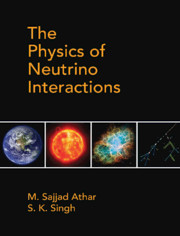Book contents
- Frontmatter
- Dedication
- Contents
- List of Figures
- List of Tables
- Preface
- Acknowledgments
- Chapter 1 Neutrino Properties and Its Interactions
- Chapter 2 Relativistic Particles and Neutrinos
- Chapter 3 Quantization of Free Particle Fields
- Chapter 4 Interacting Fields and Relativistic Perturbation Theory
- Chapter 5 Phenomenological Theory I: Nuclear β-decays and Weak Interaction of Leptons
- Chapter 6 Phenomenological Theory II: Weak Decays of Hadrons
- Chapter 7 Gauge Field Theories and Fundamental Interactions
- Chapter 8 Unified Theory of Electroweak Interactions
- Chapter 9 Neutrino and Electron Scattering from Point Particles
- Chapter 10 Neutrino scattering Cross Sections from Hadrons: Quasielastic Scattering
- Chapter 11 Neutrino Scattering from Hadrons: Inelastic Scattering (I)
- Chapter 12 Neutrino Scattering from Hadrons: Inelastic Scattering (II)
- Chapter 13 Neutrino Scattering from Hadrons: Deep Inelastic Scattering
- Chapter 14 Weak Quasielastic v(⊽)-nucleus Scattering
- Chapter 15 Inelastic Scattering of (Anti)neutrinos from Nuclei
- Chapter 16 Deep Inelastic Scattering of (Anti)neutrinos from Nuclei
- Chapter 17 Neutrino Sources and Detection of Neutrinos
- Chapter 18 Neutrino Mixing and Oscillations
- Chapter 19 Neutrino Astrophysics and the Synthesis of Elements
- Chapter 20 Neutrino Interactions Beyond the Standard Model
- Appendices
- Appendix A Lorentz Transformation and Covariance of the Dirac Equation
- Appendix B Cabibbo Theory
- Appendix C Some Properties of Pauli and Dirac Matrices and Spin Density Matrices
- Appendix D Leptonic and Hadronic Tensors
- Appendix E General Expression for the Total Scattering Cross Section and Decay Rates
- Appendix F Expressions of N(q2), the Coefficients of the Polarization Observables
- References
- Index
Chapter 4 - Interacting Fields and Relativistic Perturbation Theory
Published online by Cambridge University Press: 22 May 2020
- Frontmatter
- Dedication
- Contents
- List of Figures
- List of Tables
- Preface
- Acknowledgments
- Chapter 1 Neutrino Properties and Its Interactions
- Chapter 2 Relativistic Particles and Neutrinos
- Chapter 3 Quantization of Free Particle Fields
- Chapter 4 Interacting Fields and Relativistic Perturbation Theory
- Chapter 5 Phenomenological Theory I: Nuclear β-decays and Weak Interaction of Leptons
- Chapter 6 Phenomenological Theory II: Weak Decays of Hadrons
- Chapter 7 Gauge Field Theories and Fundamental Interactions
- Chapter 8 Unified Theory of Electroweak Interactions
- Chapter 9 Neutrino and Electron Scattering from Point Particles
- Chapter 10 Neutrino scattering Cross Sections from Hadrons: Quasielastic Scattering
- Chapter 11 Neutrino Scattering from Hadrons: Inelastic Scattering (I)
- Chapter 12 Neutrino Scattering from Hadrons: Inelastic Scattering (II)
- Chapter 13 Neutrino Scattering from Hadrons: Deep Inelastic Scattering
- Chapter 14 Weak Quasielastic v(⊽)-nucleus Scattering
- Chapter 15 Inelastic Scattering of (Anti)neutrinos from Nuclei
- Chapter 16 Deep Inelastic Scattering of (Anti)neutrinos from Nuclei
- Chapter 17 Neutrino Sources and Detection of Neutrinos
- Chapter 18 Neutrino Mixing and Oscillations
- Chapter 19 Neutrino Astrophysics and the Synthesis of Elements
- Chapter 20 Neutrino Interactions Beyond the Standard Model
- Appendices
- Appendix A Lorentz Transformation and Covariance of the Dirac Equation
- Appendix B Cabibbo Theory
- Appendix C Some Properties of Pauli and Dirac Matrices and Spin Density Matrices
- Appendix D Leptonic and Hadronic Tensors
- Appendix E General Expression for the Total Scattering Cross Section and Decay Rates
- Appendix F Expressions of N(q2), the Coefficients of the Polarization Observables
- References
- Index
Summary
Introduction
In the previous chapter, we have described free particles and fields in termsof Lagrangian, equations of motion, their solutions and quantization.However, in the physical world, particles and fields are visualized by theirinteractions with other particles and fields or among themselves. Forexample, the simple processes of Compton scattering, photoelectric effect,and Coulomb scattering involving photons and electrons, are well known. Allthe known elementary particles interact with each other through the fourfundamental interactions, that is, electromagnetic, weak, strong, andgravitational, through the exchange of gauge fields. Since the particlesthemselves can be described in terms of fields, all the physical processesgoverned by the four fundamental interactions are examples of various typesof fields in interaction with each other including self interaction, allowedby the general principles of physics. These interactions are described by aninteraction Lagrangian Lint(x),to be included along with the free LagrangianLfree(x), described inChapter 2 for a quantum description of the evolution of physical systems.The interaction Lagrangians can be obtained by using the symmetry propertiesof the physical system defined by certain transformations called local gaugetransformations and imposing the invariance of the free Lagrangian underthese transformations. These will be discussed in some detail in Chapter 8,in the case of electromagnetic, weak, and strong interactions of scalar,vector, and spin particles.
In this chapter, we give some simple examples of interaction Lagrangiansinvolving spin 0, spin and spin 1 particles and illustrate the generalprinciples to write them. We use the example of electromagnetic interactionto demonstrate the general method of the relativistic perturbation theory tofind out the solution of the equations of motion of fields in the presenceof the interaction LagrangianLint(x). It is assumed thatthe strength of the interaction Lagrangian can be quantified by a parameterwhich is small, so that perturbation theory can be applied. This is normallythe situation in the case of electromagnetic and weak interactions; in alimited range of kinetic variables, it is also true in the case of stronginteractions. The relativistic perturbation theory has been very useful indescribing physical processes.
- Type
- Chapter
- Information
- The Physics of Neutrino Interactions , pp. 139 - 166Publisher: Cambridge University PressPrint publication year: 2020



